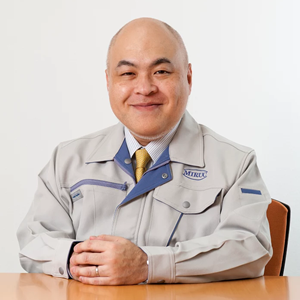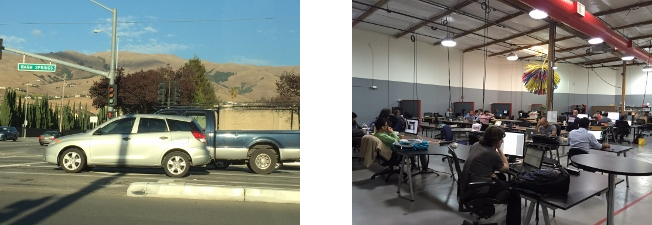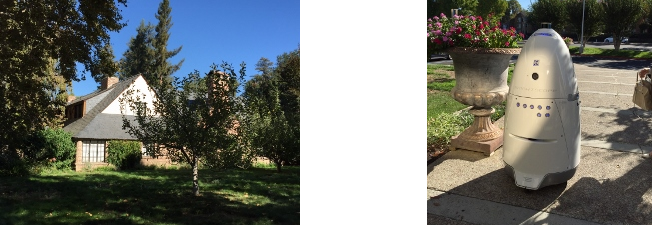chapter 2 From the manufacturing workplace, “the doorway to tomorrow
Five years have passed since the last interview, and Miruc Optical Co., Ltd. is marking the 53rd anniversary of its foundation this year.
The company is known for its long-time commitment to skillful craftsmanship and the “Japan Way” of manufacturing. How has it grown in these past five years? And what kind of transformation does it seek to achieve from now?
We interviewed President Muramatsu, who leads Miruc Optical in its endeavor to become a “100-year company,” and heard his vision for the present and future.
Interviewer: Kanda
Interview conducted on November 12 (Tuesday), 2016
Present Situation
――First of all, tell us about what you have done in these past five years.

We expanded our business abroad, acquired intellectual property rights, developed products such as low-priced versions for Asian markets, planned and launched a new business, et cetera. Looking back, I am surprised how quickly these years have passed. Over this period of time, we have been focused on “plowing a field and planting seeds.”
――Could you be more specific about your efforts to expand your business abroad?
Muramatsu:Our foray started in Germany, the home of optical devices and precision instruments and, from there, we went on to East Asia, Southeast Asia and North America. Our original purpose was to expand sales channels for our products overseas. We actively participated in trade fairs, business conventions and whatever we thought would give us a business opportunity.
――Did you benefit from those overseas trade fairs and business conventions?
Muramatsu:Of course. These events not just helped us develop new markets, but we were able to gain fresh feedback from local customers at trade fairs. We got a lot of requests and comments from customers, some of them asking, “Can you develop a new product like this?” or suggesting, “You may use this product for an application like this.” What we hear from customers slightly differs from country to country. We learned that we should adapt our products to the national characteristics and business practices of each individual country, instead of providing the same products in the same way. This helped us in developing new products.
――Have you found foreign distributors and business partners?
Muramatsu:Yes, we have now tied up with good business partners in 10 countries that serve as our distributors and retailers. Also, in addition to opening new markets, we have expanded our network with foreign companies, finding overseas suppliers capable of machining parts with the same level of quality as in Japan at lower costs and developing products through business collaboration with excellent and reliable manufacturers abroad.
――Tell us about the intellectual property rights you have acquired.
Muramatsu:We currently have more than 80 intellectual property rights in total here at home and abroad, including patent rights, design rights and trademark rights. These are intangible assets for us and a source of pride at our company where development is tantamount to creating intellectual properties.
Also, we received the “Tokyo Metropolitan Governor Prize” for the Kanto Area Invention Award for fiscal 2015, giving us social recognition and trust.
――You mentioned that you have developed low-priced versions of your products for Asian markets.
Muramatsu:While visiting countries in East Asia and Southeast Asia, I repeatedly heard local business people say, “Products made in Japan are of high quality but expensive. We can get by with less expensive Asian-made products with mediocre levels of quality and performance.”
At first, we were stubborn, thinking, “If you don’t appreciate the quality and value of Japanese-made products, we don’t beg you to buy them.” That mindset has changed, and we now see the situation this way: If the national characteristics, business practices and sense of value toward products vary from market to market, then providing products with the appropriate level of quality at the appropriate price range for each individual market is the best way to achieve customer satisfaction.
――Doesn’t that contradict your persistence in the quality of manufacturing?
Muramatsu:We have simply reversed our way of thinking (laughter).
What we did was to differentiate and create a second brand, like UNIQLO marketing products under the GU brand and major airline companies entering the LCC market.
It is customers who choose what to buy. So, as a manufacturer, we have come to see it as our mission to provide products that fulfill their needs.
――Is it possible for these different types of products to coexist and co-prosper without causing cannibalization?
Muramatsu:The Japanese-made products of our original brand can be used in many different combinations for many different applications, while the low-priced versions come in only a few models and are limited to simple applications. Differentiating these products clearly from one another has established a distinction between customer bases and helped us acquire new customers. So I think that it is possible for them to coexist and co-prosper.
Vision for the Future
――I have heard that, in addition to developing new products based on the existing ones, you have launched an entirely new business. Is there any significant reason behind this move?
Muramatsu:In 2013, we reached the 50th anniversary of the foundation of our company. Although I knew that it was very difficult for a company to stay in business for half a century, I did not propose to hold any celebratory event whatsoever. At the time, I was filled with a sense of crisis. My concern was that, should we become complacent about the current situation, even just a little, Miruc Optical would be gone five years later. Frustration kept mounting in me, pushing me to think about trying something new. What always crossed my mind were the words “the start of a second business.”
――Were you concerned about the existing products and technologies of your company?
Muramatsu:No. I believe that precise and delicate craftwork and skills of craftsmen will remain and should never go extinct. The reality, though, is that just clinging to this philosophy is not enough for us to become a 100-year company and achieve huge business growth and development. So I was desperately looking for a new framework for starting a second business.
――While you were struggling with this idea, did you find a hint that led you to the new business?
Muramatsu:Yes. I got to know “artificial intelligence” by chance.
Anyone’s reaction to this would probably be: “Artificial intelligence? It’s totally different from what Miruc Optical has dealt with in the past.” That’s what I thought myself at first (laughter).
――But you proceeded to start a business using artificial intelligence. Why?
Muramatsu:First, I consulted with a corporate executive who was senior to me. He showed a negative response, advising me against the idea. But that had the opposite effect of giving me confidence (laughter).
One of my favorite quotes is one by Bill Gates, which is:
“You are not thinking out of the box unless people laugh at your ideas at least once.”
I was so thrilled that I flew to the U.S. to do some research in Silicon Valley. “Conceive an idea, act right away. If you don’t act yourself, nothing happens.” This is my motto (laughter).

――What did you think of Silicon Valley?
Muramatsu:Actually, various research and development efforts were underway on artificial intelligence. As I broadened my knowledge about this technology, one keyword caught my attention. I’m afraid I have to keep it a secret (laughter). So I returned to Japan, feeling confident that we had a great chance to succeed by pursuing what that keyword represented.

――Wasn’t it a risk to start a business so different from your existing products?
Muramatsu:There is no business that is free of risk. You work out a strategy and then decide whether to proceed or not. I think that’s where it starts. Fortunately, Miruc Optical has been in the optical equipment business for 53 years and gained experience, trust, a delivery track record and a business network over this period of time. To make the most of artificial intelligence requires the know-how of capturing clear images of the test object (workpiece), and we have that know-how.
At a glance, the business seems entirely different from what we have been doing. But it is an extension of the existing products that we have supplied over the years.
――I see. When did you officially release the product for this new business?
Muramatsu:We officially released the product in June 2016, and the Nikkei Industrial Newspaper ran an article about it. The product is called the Artificial Intelligence Inspection System AI HAYABUSA.
The system got newspaper coverage and was exhibited at domestic tradeshows, and we did online advertising. Thanks to all this, we have received much more enquiries and business offers than we initially imagined.
――Why do you think this product has caught so much attention?
Muramatsu:Simply put, there are an extremely large number of business users who are dissatisfied and have problems with the existing inspection devices and equipment, accuracy, inspection methods and so on.
Actually, I was amazed at the enormous number of business users dissatisfied with or troubled by the current situation. They say, for example, “The existing image processor is not versatile enough to deal with various kinds of workpiece,” “Defective products cannot be detected with the required level of accuracy,” “The inspection accuracy degrades if the threshold is changed,” “We took a long process of trial and error to automate our inspection line but could not find the optimal equipment, and we still have inspections done by a large number of human inspectors,” “Our current system not only takes time and cost but is prone to human errors and quality variations, so our inspection efficiency is low,” et cetera, et cetera.
――Do you think that AI HAYABUSA solves all these problems?
Muramatsu:Yes. AI HAYABUSA utilizes artificial intelligence capability that outperforms the conventional image processing software, and the system is customized to solve problems that differ case by case. We not just develop and sell software alone but also propose and sell a whole inspection system including hardware. We can meet both of these needs.
――Tell us about how you intend to promote AI HAYABUSA from now on.
Muramatsu:AI HAYABUSA is attracting interest not only from the semiconductor, electronic component, auto and machine parts industries but also from completely unrelated industries such as foods, pharmaceuticals, agriculture and seafood processing, and we are receiving concrete business offers.
Since AI HAYABUSA is a custom product, we need to have discussions with the customer repeatedly and it takes time before the specifications are finalized. But it can be applied to any category of business as I just mentioned. So we are going to think outside the box and promote AI HAYABUSA to all kinds of industry. We would like to spread the system as a solution business and contribute to society on a broad basis.
――Finally, tell us about the future prospects of Miruc Optical.
Muramatsu:Miruc Optical has craftsmanship only possible through precise and delicate craftwork that we have nurtured since its foundation (analog technology) and a solution business that leverages artificial intelligence (high technology). Taking advantage of both of these two types of technology, we are going to “open the doorway to tomorrow” and move forward with our second business. And we intend to expand our business fields further along the way.
We count on the customers’ continued patronage of our products.
――Thank you for having us today.
AfterwordEvolving toward the “Japan Way” of Manufacturing ――。
While conducting the interview, I got the impression that the past five years have given “flexibility” to Miruc Optical, a company that has always taken pride in making things in Japan.
Talking with President Matsumura, who told me smilingly how his business life has been full of troubles, I got a glimpse of the passion and wisdom of a man who has hit a number of walls in expanding the business abroad and developing new products and overcome every one of those walls without ever giving up.
Miruc Optical has learned what to keep and what to create anew, which has undoubtedly brought the company to a new stage.
Miruc Optical is now collaborating with manufacturers around the world, avidly absorbing their knowledge and technologies. Its endeavor to evolve toward the “Japan Way” of manufacturing will go on.
>chapter1 From the manufacturing workplace, “the doorway to tomorrow”